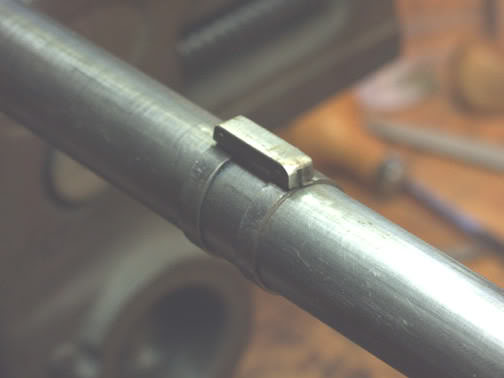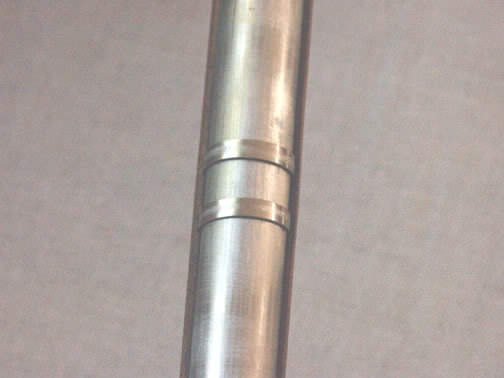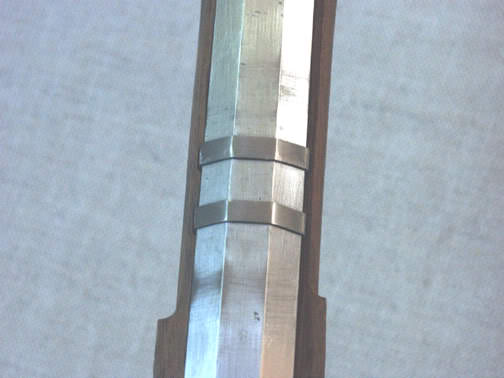I have a question regarding the barrel attachment to stock methods. I'm thinking of getting a Brunswick or Baker pattern rifle. Those use keys to attach the barrel to the stock. Later Enfield pattern rifles use bands to attach the barrel to the stock. It's not like bands were a new thing since the French muskets used them. My question is why was the change made to go from keys to bands? Does one method lead to a more inherently accurate rifle?
-
Friends, our 2nd Amendment rights are always under attack and the NRA has been a constant for decades in helping fight that fight.
We have partnered with the NRA to offer you a discount on membership and Muzzleloading Forum gets a small percentage too of each membership, so you are supporting both the NRA and us.
Use this link to sign up please; https://membership.nra.org/recruiters/join/XR045103
You are using an out of date browser. It may not display this or other websites correctly.
You should upgrade or use an alternative browser.
You should upgrade or use an alternative browser.
Barrel keys vs bands
- Thread starter lardener
- Start date

Help Support Muzzleloading Forum:
This site may earn a commission from merchant affiliate
links, including eBay, Amazon, and others.
- Joined
- Nov 26, 2005
- Messages
- 5,153
- Reaction score
- 10,572
Hi,
It has nothing to do with accuracy and everything to do with production costs, lightening the stock, and easier field maintenance. The production costs are reduced because barrels do not need lugs brazed or dovetailed on, stocks can be lighter because the security of the barrel attachment to the stock is less dependent on strength of wood and bands are stronger than pins or keys, and it is easy to slip the bands on and off to remove barrels than tapping out keys, which risks damaging the stock if the punch slips. Having said all that, the Spanish used bands on sporting guns very early (17th century) because their barrels were so fine they were concerned that heating them to braze on lugs would cause scale in the bore, ruining the shooting properties.
dave
It has nothing to do with accuracy and everything to do with production costs, lightening the stock, and easier field maintenance. The production costs are reduced because barrels do not need lugs brazed or dovetailed on, stocks can be lighter because the security of the barrel attachment to the stock is less dependent on strength of wood and bands are stronger than pins or keys, and it is easy to slip the bands on and off to remove barrels than tapping out keys, which risks damaging the stock if the punch slips. Having said all that, the Spanish used bands on sporting guns very early (17th century) because their barrels were so fine they were concerned that heating them to braze on lugs would cause scale in the bore, ruining the shooting properties.
dave
I agree Dave.
Pins or wedges require brazed or dovetailed underlugs on the barrel.
Clearance for the underlugs must also be cut into the stock barrel channel.
Then, they require assembling the gun and drilling the pin holes thru the stock and underlugs.
If wedges are used, the drilled holes require work to shape the slots to match the wedges.
Using a barrel band eliminates all of these steps.
The barrel is installed in the stocks barrel channel and the band is installed and in some cases, the band screw is tightened.
In other cases, a hole and slot are made to match a barrel band spring but installing this does not take the precision needed to make pins or wedges work.
Pins or wedges require brazed or dovetailed underlugs on the barrel.
Clearance for the underlugs must also be cut into the stock barrel channel.
Then, they require assembling the gun and drilling the pin holes thru the stock and underlugs.
If wedges are used, the drilled holes require work to shape the slots to match the wedges.
Using a barrel band eliminates all of these steps.
The barrel is installed in the stocks barrel channel and the band is installed and in some cases, the band screw is tightened.
In other cases, a hole and slot are made to match a barrel band spring but installing this does not take the precision needed to make pins or wedges work.
Col. Batguano
75 Cal.
- Joined
- Feb 10, 2011
- Messages
- 5,038
- Reaction score
- 1,415
When a banded gun was made, did they build the gun and then make the band to fit the spot, or the other way around? It seems to me that banding barrels in place is better suited to mass production than 1-off custom guns.
Come to think of it, I can't recall seeing ANY "fine guns" that were made as banded. This obviously will only work on either a straight or tapered stock. Highly swamped barrels need not apply, unless there is something of a loosening / tightening mechanism for the band itself.
Come to think of it, I can't recall seeing ANY "fine guns" that were made as banded. This obviously will only work on either a straight or tapered stock. Highly swamped barrels need not apply, unless there is something of a loosening / tightening mechanism for the band itself.
- Joined
- Nov 26, 2005
- Messages
- 5,153
- Reaction score
- 10,572
Hi David,
Good questions. I have built several military guns that required barrel bands. It is easy to see how a series of templates or jigs would make that a straight forward task. Plus the bands are much stronger than keys or pins holding the barrel in place and lighter stocks can be used. Also keep in mind that with no barrel lugs, the thickness of the web of wood between barrel and ramrod channels can be very small with the ramrod hole and groove parallel with the underside side of the barrel so the ramrod clears the forward lock bolt. For civilian guns, the Spanish barrel were considered the best in the world during the 17th and 18th centuries. They were so good because they used the purest iron ore in Europe (from northen Spain) and they welded barrels in 5 sections. Two for the octagonal part and 3 for the round part. By the way, octagon to round barrels with the traditional "wedding band" were called "Spanish form" in the 18th century. Each short section could be inspected very closely and then when they were welded together, the 4 welds could be closely inspected. Good welding and good iron made for light, thin walled barrels that were highly prized. The Spanish used barrel bands to hold the barrels in the stocks because they did not want to affect the shooting qualities of their light barrels by heating to braze on lugs. I own an original English fowler made in 1767 with a beautiful 40" 14 gauge Spanish barrel by Eudal Pous of Barcelona that weighs only 3 lbs. When young sporting gentlemen from England did their traditional "Grand Tours" of Europe, they often bought fine Spanish barrels and then had their favorite London makers build them into a gun. In many cases those gunmakers chose to attach the barrel to the stock with inletted barrel bands that formed a loop for barrel keys. They did that to avoid heating the barrels to braze or solder on lugs. They esteemed the barrels so much that they worried the heating would scale the bores. The photos below show my reproduction of those bands on a fowler I am building.
dave




Good questions. I have built several military guns that required barrel bands. It is easy to see how a series of templates or jigs would make that a straight forward task. Plus the bands are much stronger than keys or pins holding the barrel in place and lighter stocks can be used. Also keep in mind that with no barrel lugs, the thickness of the web of wood between barrel and ramrod channels can be very small with the ramrod hole and groove parallel with the underside side of the barrel so the ramrod clears the forward lock bolt. For civilian guns, the Spanish barrel were considered the best in the world during the 17th and 18th centuries. They were so good because they used the purest iron ore in Europe (from northen Spain) and they welded barrels in 5 sections. Two for the octagonal part and 3 for the round part. By the way, octagon to round barrels with the traditional "wedding band" were called "Spanish form" in the 18th century. Each short section could be inspected very closely and then when they were welded together, the 4 welds could be closely inspected. Good welding and good iron made for light, thin walled barrels that were highly prized. The Spanish used barrel bands to hold the barrels in the stocks because they did not want to affect the shooting qualities of their light barrels by heating to braze on lugs. I own an original English fowler made in 1767 with a beautiful 40" 14 gauge Spanish barrel by Eudal Pous of Barcelona that weighs only 3 lbs. When young sporting gentlemen from England did their traditional "Grand Tours" of Europe, they often bought fine Spanish barrels and then had their favorite London makers build them into a gun. In many cases those gunmakers chose to attach the barrel to the stock with inletted barrel bands that formed a loop for barrel keys. They did that to avoid heating the barrels to braze or solder on lugs. They esteemed the barrels so much that they worried the heating would scale the bores. The photos below show my reproduction of those bands on a fowler I am building.
dave




It seems I'm even more ignorant of this type of rifle construction than I thought. My thinking was that between the hooked breech and the keys the barrel was tensioned into place. I thought the barrel bands were a less secure method as there would be some clearance above the barrel that would allow the barrel to vary within the channel.
So my question actually inverts. Given all the advantages of bands over keys, why did the British take so long to switch?
So my question actually inverts. Given all the advantages of bands over keys, why did the British take so long to switch?
Most of the long arms that used the band to secure the barrel were smoothbore muskets.
A little slop or looseness between the barrel and the stock is inconsequential (it doesn't mean much), when the gun itself, regardless of the barrel retaining system is not made for accuracy. It's made to send a lot of large balls downrange at the enemy quickly.
A little slop or looseness between the barrel and the stock is inconsequential (it doesn't mean much), when the gun itself, regardless of the barrel retaining system is not made for accuracy. It's made to send a lot of large balls downrange at the enemy quickly.
- Joined
- Jan 31, 2009
- Messages
- 12,721
- Reaction score
- 6,848
Well yall, there's bands and then there's bands.
The French style of bands such as adopted by the American military is a slip-on affair meant to keep things from falling apart with heavy use but be easy to remove for maintenance. The British style of bands slip over the barrel and stock but then tighten up with a machine screw at the bottom. If properly mated the British style bands will slightly compress the barrel and stock together.
The French style of bands such as adopted by the American military is a slip-on affair meant to keep things from falling apart with heavy use but be easy to remove for maintenance. The British style of bands slip over the barrel and stock but then tighten up with a machine screw at the bottom. If properly mated the British style bands will slightly compress the barrel and stock together.
Similar threads
- Locked
- Replies
- 10
- Views
- 1K
- Replies
- 12
- Views
- 2K




